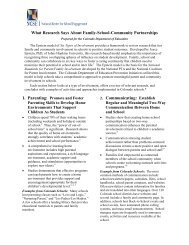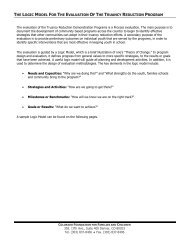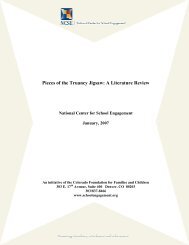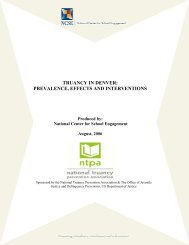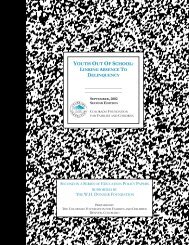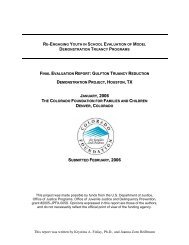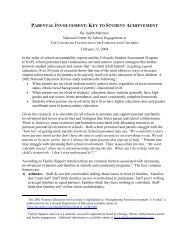Section 1: Academic Achievement - National Center for School ...
Section 1: Academic Achievement - National Center for School ...
Section 1: Academic Achievement - National Center for School ...
Create successful ePaper yourself
Turn your PDF publications into a flip-book with our unique Google optimized e-Paper software.
more affluent, stable neighborhood students. However, there were some clear differences of<br />
the” haves” and “have nots” families and their students. Even though our school made<br />
conscious ef<strong>for</strong>ts to make the differences invisible at school, the integration didn’t permeate<br />
much beyond the school walls. The “haves” tried to cross the boundaries but didn’t<br />
understand the fragile plight of the homeless/highly mobile. The “have nots” didn’t have the<br />
resources, the social register and sometimes motivation to associate with the others. “In the<br />
shadows of poverty, off the highways of prosperity, the distance from aspiration to<br />
achievement is strewn with social policies and obstacles whose number, intensity, and<br />
complexity is disheartening and debilitating.” (Cooper) I wanted to do something to<br />
improve the situation and blur the lines that were starting to be drawn in the sand.<br />
When my principal first shared the idea of this project, Web Based Professional Development<br />
(WBPD) to study the effect of homelessness on elementary schoolchildren, I was quite<br />
excited. This was an opportunity to better understand the dilemma of homelessness and<br />
education and be able to create some solutions <strong>for</strong> the students and their families in our<br />
school. When Lowry Elementary was accepted into the WBPD, we thought we were going to<br />
do a group project all together. However, it quickly became clear that we would each do our<br />
own project, thus allowing each of us to follow/pursue our individual passion. We met on a<br />
regular basis to discuss our thoughts and ideas. It was very helpful to have such a group so<br />
we could brainstorm and problem-solve together. Other researchers did not have this<br />
advantage to the extent that we did. In the absence of an on-site group, the on-line chats and<br />
discussions are invaluable <strong>for</strong> checking in, seeing if you’re on the right track, bouncing<br />
around ideas or just sharing insights.<br />
There seemed to be so many areas <strong>for</strong> us to fix from feeding and clothing students, to<br />
improving their living situations to more realistic education-based solutions such as, assisting<br />
with school supplies, making enrollment easier and integrating them into the school culture.<br />
Certainly, fund-raising was a common theme. Most of our ideas had a common theme of<br />
giving tangible items to our students and their families. However, referring to the old saying,<br />
“Give a man a fish, you feed him <strong>for</strong> a day, teach a man to fish, you feed him <strong>for</strong> a lifetime,”<br />
we didn’t want to just alleviate a short-term problem but help them be more self-sufficient.<br />
Action Research to Study Homelessness and High Mobility in <strong>School</strong> Communities 32




